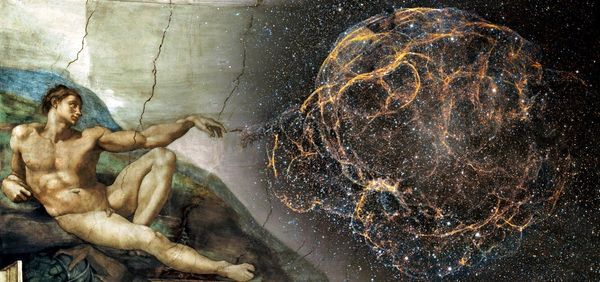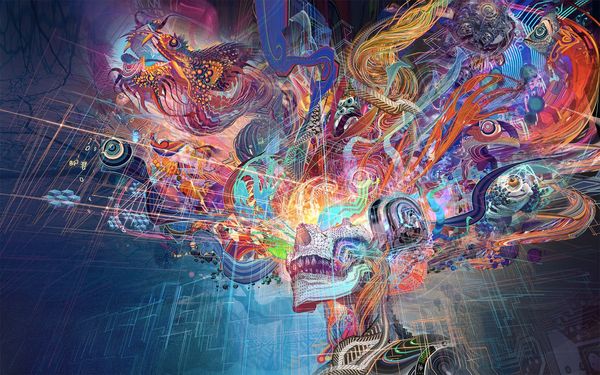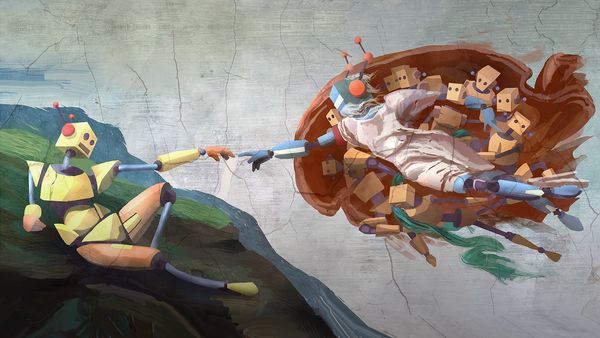Tiago Forte • • 15 min read
6 Mind-Boggling Things I Learned About the Future by Reading 100 Science Fiction Books

Over the past two years I’ve read 100 sci-fi novels, averaging about one per week. See the full list here, with my favorites.
I started reading sci-fi to pass the time. I had good memories of reading Jurassic Park as a kid. I continued because I noticed that it gave me a stronger imagination and a disrespect for the merely possible.
I started noticing I had different ideas, ideas you can’t find by reading the same TechCrunch articles, Medium posts, and Hacker News digests as everyone else. Personally, I am in the business of selling ideas, and found these books both a treasure trove and a toolkit.
As futurist Jason Silva says:
“Imagination allows us to conceive of delightful future possibilities, pick the most amazing one, and pull the present forward to meet it.”
I believe reading these books has helped me both in the conceiving and the pulling.
Every good sci-fi story is, at its core, a thought experiment. Now I’d like to run one of my own:
What if these books represented a fair guess at what the future will be like?
It’s not so far-fetched. Reading the early classics by Jules Verne and H.G. Wells, what struck me was not how much they got wrong, but how much they got right. I drew my selections mostly from this list of the top 100 sci-fi works of all time, so these books represent what we consider the best (or at least the most interesting) ideas out there.
So without further ado, here is the future we are headed for as predicted by history’s greatest sci-fi writers…
Read: 10 Ways the Next 10 Years Are Going To Be Mind-Blowing
1. In order to save humanity, we must lose it
We all know that the long-term survival of our species depends on colonizing other planets, and eventually other solar systems. It is not a question of if our planet will become unsuitable for life, it’s a question of when.
But looking at the distances and timescales involved, it’s clear that as soon as we begin this process, we will start to drift apart.
It will start with language and culture. Settlements on the outer planets, separated by millions of miles and hours of transmission time, will start to develop their own dialects, their own slang, their own music, their own trends. Looking at just the variation within the English language, between highland Scotsmen and California surfers, South African boers and Caribbean creole, gives you just a hint of the cultural drift we will see.
Next will be political and economic drift. Just as the emerging American cultural identity was reinforced by the American Revolution, the colonies will begin to see themselves as different because they are different, and demand a government that represents their interests. With large distances, we will be able to put down the first few rebellions, but it is only a matter of time before they break away.
Economic integration will expand, but far slower than our speed of colonization and exploration. By the time we are able to fully integrate these colonies into our economy, they will already developed self-sufficient economic systems.
Finally, we will begin to see genetic drift. It is remarkable to think that, despite our huge diversity here on Earth, we are all one species. Any individual could reproduce with any other individual of the opposite sex, going all the way back for 160,000 years.
But this is just a historical accident. For much of pre-history, at least a few hominid species roamed the planet, and it was only the rapid emergence and expansion of homo sapiens out of Africa and around the world that unified us.
The moment some of us leave the planet, our DNA will begin to diverge again. Starting with a limited gene pool and subject to different pressures, different sources of mortality, different levels of radiation and mutation, the spacefarers will embark on a new evolutionary path.
Eventually, whether it takes hundreds of years or thousands, one fateful mutation in one distant, isolated colony will make reproduction impossible, cutting off that branch forever.
In order to save humanity we must colonize the stars, and in doing so the unified definition of humanity as we know it will be lost.
2. Time will be our greatest enemy
As we conquer the 3 dimensions of space, the 4th dimension of time will increasingly become the greatest challenge we face.
The three dimensions up/down, left/right and forwards/backwards. But we can be in a place without a time, that’s the fourth dimension.
The first reason is time dilation, a proven consequence of relativity most recently explored in the movie Interstellar, but which plays a major part in dozens of sci-fi stories going back decades. Time dilation is the phenomenon of time passing at different speeds depending on how fast you are moving. Someone traveling close to the speed of light will age more slowly relatively than someone still on Earth.
The consequences of this one phenomenon are staggering. Long-term space travelers will return to their home planet with everyone they know dead and gone. Families will be stretched across centuries, with people outliving their great-great-grandchildren. Historical figures will emerge from space capsules still young. Those who want to see the future will be sent off on a long, high-speed roundtrip, arriving at a time they specify. It will be like having a time machine with only a forward setting.
Read: When Everything Happens Now: The Interplay of Timing, Time and Technology
The second reason is the immense distances involved in interstellar space travel. It is likely that the first to embark on an interstellar voyage will not be the first to arrive — as they are in transit, new technology will be developed allowing later expeditions to overtake them. Imagine going into cryogenic sleep as the first group of interstellar explorers, only to wake up and find your target system has been colonized for hundreds of years.
A third reason is technology differentials. Technology will be so important to every aspect of spacefaring civilizations, and will be improving so quickly, that even small differences will have profound consequences:
- Two systems with slightly different speeds of technological development will find a huge gap between them after a few decades or centuries. Their societies may be so fundamentally different that communication and exchange between them is difficult.
- Technology sent to distant systems will be obsolete by the time it gets there. Even sending information at the speed of light may not be fast enough for systems that are light-years apart. This will make trade based on anything but raw materials extremely difficult.
- War across vast distances will be futile, because any attack force sent at sub-light speeds will be obsolete by the time it arrives. But this could also mean a never-ending war that no side can win, as Joe Haldeman describes in Forever War.
We are already experiencing the limitations of time in space travel. In a recent documentary on the Rosetta spacecraft launched by the European Space Agency to land on a comet, they reveal that the probe’s Osiris camera is only 4 megapixels, which was the most advanced technology available when it was launched in 2004. Today it wouldn’t even make it into a smartphone.
The Philae lander that emerged from Rosetta to land on the comet was equipped with thoroughly tested harpoons and drills for the ice we thought it would be landing on. But in the intervening years we’ve discovered that the comet’s surface is actually a mixture of dust, gravel, and ice, making this equipment less than ideal for the job.
As the years go by, our common experience of time will break down, and we will find that the 4th dimension presents us with far greater challenges than our basic 3 physical dimensions ever did.
3. The future will be weird
If I had to pick one word to describe the future, as seen by the stories I found most compelling and believable, it would be weird. Let me explain.
Writers like Ray Kurzweil have done a good job of explaining why it is so difficult for us to envision the future that we’re headed toward. He argues that all of our ancestral heuristics are linear — tracking an antelope running across a savannah, estimating how much time a store of food will last — but that due to Moore’s Law, we are entering a phase of exponential change that these heuristics are ill prepared to handle.
In other words, we look at the rate of change from the recent past, and extrapolate to the near future. But now that we are hitting the exponential part of the graph, this kind of extrapolation doesn’t apply.
I find this argument compelling, but what is most interesting to me is not just the speed of change, but the unpredictability of its direction. The stories I’ve read have led me to believe that we are barely aware of the smallest implications of some of the technologies we are developing, and that these implications are downright strange.
Take dating for example. What will dating be like in a world of highly advanced anti-aging treatments? Imagine a man and a woman on a date. They both look about 25, but their appearance means nothing. They have to play an intricate game of testing and probing each others’ pop culture knowledge to try and determine each others’ age, without giving away their own. There will be whole industries and schools of thought around how (why?) to date people who are decades (centuries?) older or younger than you.
The area we’ll see this weirdness in the soonest is virtual reality. It’s funny to me that most portrayals of advanced virtual reality assume it will be like normal reality, with lifelike human bodies in lifelike worlds. But I think that we will very quickly realize that reality is a bug, not a feature.
What form would you take if you could take any form? There will be vast industries dedicated to helping us experience life as other people, as animals, as inanimate objects, as aliens. Other industries will be dedicated to designing environments, laws of physics, mental states, personalities, memories, and many other things we will have control over. Robin Wright’s 2013 independent film The Congress does a great job of envisioning such a world.
But the best example of how the future will be weird is artificial intelligence.
The premise of the technological singularity is that there is a point in our future beyond which we cannot see. Presumably this point is when human-level artificial intelligence gets access to its own source code, setting off an exponential intelligence explosion.
But what exactly does it mean to have “super-human” intelligence? What could we expect from a computer that has, say, a million times the computing capacity of all the humans that ever lived?
We presume that it would fill its time with “difficult” tasks, like solving world hunger, modeling the Earth’s climate, unraveling the structure of the brain, etc. But this is our anthropomorphic, linear thinking acting up again.
We can explore this through an analogy:
Imagine an ant observing the behavior of a human. From the ant’s point of view, the human doesn’t spend its time “solving hard ant-centric problems.” Virtually nothing the human does is remotely comprehensible, nor even observable, since the scale and complexity of the human’s simplest action is far beyond the ant’s conception. From what it can observe, I think the word this ant would most likely use to describe the human is “weird.”
And this is how we will describe the actions and thinking of super-human AI. If the intelligence explosion really does happen, it will very quickly become as superior to us as we are to the ant, and beyond.
Who knows what path they would take? Maybe they invent a new logic system incompatible with human neurology. Maybe they discover that our universe is a simulation and make contact with our creators, negotiating a cultural exchange. Maybe they use pure math to deconstruct dark matter and shift our reality into alternate quantum states where they are the creators, and we are artificial. Most probably, they will do things we don’t even have the language to describe.
4. The more advanced technology becomes, the less it matters
Nearly every vision of the future I’ve come across has one glaring thing in common: it is dominated by visible technology. This kind of unthinking consensus is the first clue that it’s wrong.
In nearly all these stories, technology is something intrusive, physical, monolithic, and self-centered. Cities are represented as vast seas of endless chrome, not a tree in sight. Apartments are covered in plastic panels and bulky appliances, like a 1960’s space capsule. Our bodies are intertwined with crudely designed machines, implying that transhumanism will be mostly about humans becoming more machine-like, not the other way around.
But it’s so clear to me that this is not how technology will evolve at all. These are the predictions of a civilization that has just discovered gadgets, one that is deep in the throes of neomania, an obsession with everything new, that can only imagine a future with BIGGER everything. It’s like a child who assumes adulthood will be characterized primarily by bigger and more expensive toys (although I know adults who do, in fact, still think that).
A much more realistic and compelling vision for what technology will ultimately become is The Force, from Star Wars. Think about it. It has the best interface imaginable: no interface at all. There is no delay between thought and action, no barrier between subject and object. The Jedi Knight never has to wonder if he’s upgraded to the latest version, never has to charge the battery, or remember the wifi password.
The Force is everywhere, and nowhere; it can be used for evil, but has higher potential for good; it is a spiritual force, but eminently practical. The day that I can reach out my hand and, with nothing but my thoughts, make my intentions manifest in the real world, will be the day that technology can be considered grown up. Not before.
What I think will happen is this: technology will slowly disappear. It will fade into the background, vanishing into walls and furniture and clothing, shrinking its form even as it expands its function. It will get quieter and calmer, built with the specific intention of preserving our mindfulness, not just grabbing our attention, as we realize that creative focus is the only thing that can’t be automated. Think ancient Greece instead of Blade Runner — the world will be dominated by ideas, not tools.
In the future, technology as we know it simply won’t be important, because its ultimate purpose is to work itself out of a job — to finally outgrow its need for constant maintenance and troubleshooting and allow us to decide what we really want to use it for. It will cease to be an end in itself, and become instead a means to things that are much more important.
5. Collective consciousness is both our greatest hope, and our greatest fear
The image most people have of science fiction is space opera — massive starships flying through hyperspace, lasers, exploration of alien planets. In short, Star Trek.
But as entertaining and imaginative as space opera can be, it is the stories that explore “inner space” that fascinate me the most. Science fiction has the unique capability of creating external thought experiments to explore inner states. Our minds are not good at abstraction — our thinking is much more revealing when it revolves around a concrete story that actually has some basis in reality (hence the “science” part).
Let me give you an example.
There is something very curious I’ve noticed: in story after story, the ultimate destiny of mankind is some form of collective consciousness. Whether it’s the Gaia planetary super-organism in Foundation’s Edge, or the nanodrug-enabled communion of Nexus, there is something very utopian and exalted about the idea of joining our minds in shared experience. I was shocked to hear that there’s actually serious research on the possibility of “panpsychism” — the idea that everything in the universe has, or at least has the potential to have, consciousness.
But at the same time, this terrifies us. It is striking how often the alien enemy is some sort of bug-like, collective groupmind. We seem to regard the hive or swarm as the antithesis of everything we represent as humans. In Solaris, a planetary superorganism is terrifying not because of its evil intentions, but because it doesn’t seem to have a centralized consciousness we can understand. In Ender’s Game, worker and soldier bugs are controlled remotely by a queen (in how many movies is the solution to destroy the queen or overmind, causing all the drones to suddenly drop dead?). And of course we all remember the Borg, which is scary precisely because it is made up of once sentient beings, their individuality now subsumed.
For me this tension illustrates one of the central struggles of humanity far more effectively than a million pop psychology books. We crave connection like the air we breathe, and yet vulnerability feels like an existential threat. Study after study tells us exactly what we need to be happy, regardless of time, culture, age, or personality : intimate social relationships.
So why is happiness so hard to find?
Because relationships involve short-term risks and uncertain long-term rewards. Like the characters in the grandest space opera, we have to leave our comfort zone to find fulfilment, even if our “spaceship” is just a desk.
Collective consciousness is both our greatest hope, and our greatest fear. Maybe the hardest part about creating a “human-like” intelligence won’t be that we’re so smart, but that we’re so confusing.
6. Complexity and chaos, not the size of transistors, will be our obstacles
Here’s how I know we’re in a tech bubble: the idea that technology is everything, will solve every problem, and will soon eclipse every area of human endeavor is increasingly the only acceptable opinion. Anything else is met with breathless, shrill protests.
I can’t say I’ve been completely immune. Reading Ray Kurzweil’s The Singularity is Near was an almost transcendent experience, the modern equivalent of seeing the future through a crystal ball. The arguments are so damn compelling, so self-evident, so apparently scientific (they have graphs!). The danger of being left behind seems to be growing, while being ahead of your time is increasingly a badge of honor. The result is we try to outdo each other with ever-sooner predictions for a given breakthrough (self-driving cars in ten years! No, five!), as if faith in the singularity is the only way to gain admittance.
At the same time, it really bothers me that the only alternative to blind faith in an imminent singularity is fundamentalist mysticism — consciousness as an ineffable mystery, the human mind a black box not subject to the laws of physics. This is exactly how we thought about the universe before Copernicus blew it open for us.
But what does science fiction have to say on the topic? Can it help us imagine plausible alternatives to a smooth, shining path to utopia, without relying on appeals to mysticism?
Here’s just one example of such a scenario:
There is the intriguing possibility that human-level consciousness cannot be simulated, not because it is too mysterious, but because of inherent characteristics of complexity. Our understanding (never mind our management) of complex systems still seems pretty dismal (see Malaysia Airlines flight 370, 2008–2009 financial crisis, and the recent missing-in-action Snowmageddon of 2015).
This is the foundation of chaos theory: that complex systems are not linear; their causes and effects are not like vector graphics that can simply be scaled to whatever size. There are tipping points — critical thresholds of reactivity and amplitude, like hitting a miniature golf ball just imperceptibly harder than your partner, sending it barely over a slope, and into a whole new maze of tunnels and obstacles.
There was an intriguing idea I remember reading about in a book on chaos theory: that there are complex systems that cannot be modeled. For example, problems that can only be solved by algorithms which run in superpolynomial time, which (very) basically means that the time required to compute them increases exponentially in relation to the inputs, making them impractical to use.
Just imagine if human consciousness happens to be such a problem — a system that cannot be modeled does not benefit from exponential improvements in computation, or recursive self-improvement. Even if we succeed in making computers equivalent in every way to our own brains, they would be forced to run operations in real time in this scenario. They would be limited not by the “number of angels dancing on the head of a pin,” but by the very principles of the logic on which they run.
Oh the delicious irony!
Why It Matters
There’s many other interesting ideas I picked up from my reading, but since this post is getting long, I’ll wrap it up.
When I started reading sci-fi, I thought it was just a fun way of envisioning the future for my own personal enjoyment. But I’ve started to learn about a whole range of methods that rely on the principles of science fiction, if not the stories themselves, to make things in the real world. Storytelling and science are two of the most powerful tools we have access to — combining them has great potential.
I started with a book called Science Fiction Prototyping: Designing the Future with Science Fiction. It was recommended to me by a senior executive at the firm I worked for at the time, as the most important book he could recommend for innovation, and my curiosity was piqued.
It describes a loose process of using the common elements of sci-fi stories to conceive and test the implications of new technologies. Just as storytelling mirrors human experience, SF prototyping uses fiction to explore the potential experience of new technologies.
One of my favorite futurists, Thomas Frey, uses a process he calls “situational futuring” to rapidly generate and examine plausible future scenarios, which can be used for everything from geopolitical strategy to product development. The sheer volume of fascinating scenarios he comes up with on his blog is convincing proof of the method.
I’ve even recently learned about Appreciative Inquiry, a model created at Case Western Reserve University as an answer to our obsession with problem solving (which, it claims, focuses on problems instead of solutions). It is based on the “anticipatory principle,” which posits that “what we do today is guided by our image of the future.” Appreciative Inquiry “uses artful creation of positive imagery on a collective basis to refashion anticipatory reality.”
I’m not sure how that translates into practice, but do think it’s worth noting that someone is working to make sci-fi prototyping into a more rigorous approach.
The bottom line is, the line between science and science fiction is becoming very blurry. Every single day seems to bring news of a mind-boggling discovery, advancement, or invention that wasn’t supposed to happen for years. The ability to create purely imagined future scenarios, and to work out the subtle implications of radically new capabilities, is not of use only to novelists anymore — it is becoming a key skill for creating those capabilities in the first place.
Author Nassim Taleb in his book Antifragile discusses a rule of thumb he uses to estimate how long something will be around: the longer it’s been around, the longer it’s likely to remain. By this measure, even as the specific technologies come and go, even as we experiment with virtually every aspect of our environment and consciousness, the storytelling instinct will continue to be a fundamental human trait.
I suggest we learn how to use it to tell stories about a future worth creating.
Would you be interested in a short ebook on how to use sci-fi prototyping in your business? No promises, but if you sign up here I’ll keep you in the loop.
And/or follow me on Twitter @fortelabs










